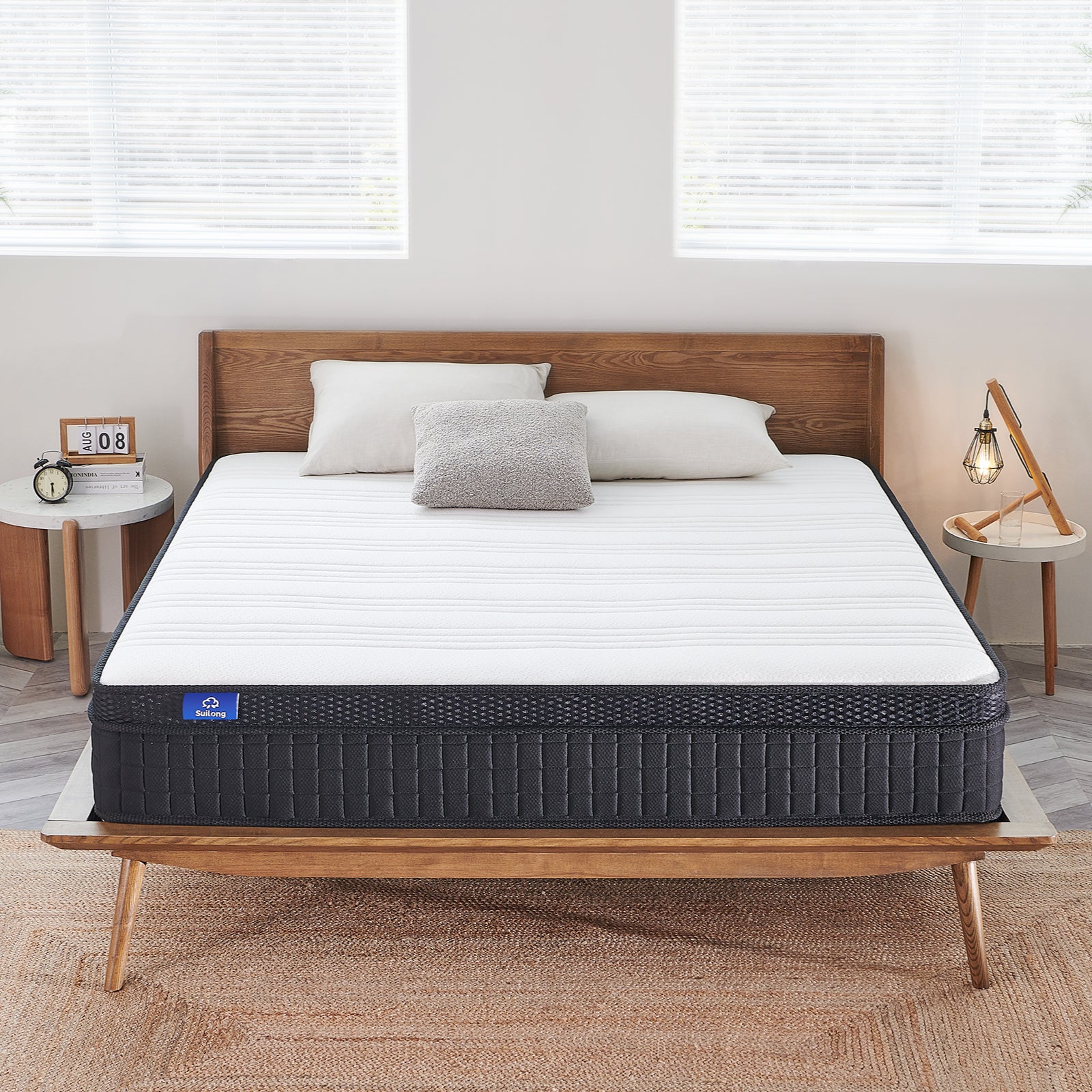Is Memory Foam Good For Pressure Relief?

Explore the wonders of memory foam mattresses for pressure relief in our expert guide. Discover how to choose, use, and maintain the perfect mattress for a restful sleep. Ideal for those with pressure sores or seeking enhanced comfort.
1. Memory foam mattresses: the magic solution for stress relief?
1.1 Memory foam mattresses for pressure points
The key to the popularity of the memory foam mattress is its unique material. This material deforms according to your body temperature and weight, thus providing you with customised support throughout your sleep. Imagine a mattress that adapts precisely to your body's curves, dispersing pressure points and reducing the number of times you turn over, helping you enjoy a deeper night's sleep. That's the beauty of a memory foam mattress.
1.2 Memory Foam and Pressure Sores: An Effective Method of Prevention and Relief
Pressure sores, especially a nightmare for long-term bedridden patients, often form due to constant pressure. And memory foam mattresses play an important role in this regard. Its pressure-dispersing ability significantly reduces pressure in specific areas, preventing the formation of pressure sores. At the same time, memory foam's breathability and temperature regulation also help to keep the skin healthy and reduce the risk of pressure sores.
1.3 User testimonials: How did they experience memory foam?
From social media to consumer forums, user reviews of memory foam mattresses are mostly positive. They typically report a significant improvement in sleep quality since using a memory foam mattress, and waking up in the morning with significantly less body aches and pains. Of course, each person's experience is individualised, but it generally reflects the effectiveness of memory foam mattresses in improving sleep comfort and relieving body pain.
Read on to learn how to choose the best mattress for pressure relief and build a solid foundation for your quality of sleep.
2. How to Choose the Best Mattress for Pressure Relief
2.1 Comparison of different types of mattresses for pressure relief
When choosing a mattress, it is important to understand the different types of mattresses available. Traditional spring mattresses provide good support but may not be as effective as memory foam mattresses in distributing pressure. In contrast, memory foam mattresses stand out due to their unique pressure-dispersing properties, and are particularly suitable for people who need to focus on pressure points. In addition, hybrid mattresses, which combine the benefits of memory foam and springs to provide balanced comfort and support, are another option worth considering.
2.2 Choosing the right mattress for someone with pressure sores
Choosing the right mattress is especially critical for those at risk of pressure sores. Memory foam mattresses are often considered ideal for preventing and relieving pressure sores due to their excellent pressure relief capabilities. This type of mattress reduces pressure on the body at the point of contact with the mattress, helping to reduce or prevent the formation of pressure sores.
2.3 Buyer's Guide: Buying the Right Memory Foam Mattress for You
When buying a memory foam mattress, there are a few key factors to consider: density, thickness and firmness. High-density memory foam mattresses typically offer better support and durability, but they can also be hotter. You'll also need to choose the right firmness and thickness based on your sleeping habits (e.g., sleeping on your side, back, or stomach) and personal preferences.
Next, let's dive into how to properly use and care for your memory foam mattress to ensure you get value for your investment.
3. Proper use and care of a memory foam mattress
3.1 How to use a memory foam mattress correctly?
Proper use of a memory foam mattress can greatly extend its lifespan. Firstly, make sure that the mattress is stored flat and avoid folding or bending it for long periods of time as this can damage its internal structure. Secondly, consider using a mattress protector to prevent stains and dust from accumulating. In addition, rotating the mattress regularly will ensure even wear and prolong its comfort.
3.2 Cleaning and Maintenance of Memory Foam Mattresses
Cleaning of a memory foam mattress is crucial. The surface of the mattress should be vacuumed regularly to remove dust mites and other allergens. For stains, wipe gently with a mild detergent and a damp cloth, avoiding strong chemical cleaners. Most importantly, give the mattress enough time to dry in a well-ventilated environment.
3.3 Frequently Asked Questions
Many users may have questions about memory foam mattresses, such as the "smell" of a new mattress, the best choice of bed base, etc. These odours usually dissipate naturally within a few days. These odours usually dissipate naturally within a few days. As for the bed base, it is recommended to use a firm, flat base to provide even support.
Now, let's turn to the sleep guide for pressure ulcer sufferers to learn how to reduce discomfort and improve the quality of sleep in bed.
4. Sleep Guide for People with Pressure Sores
4.1 How to Reduce the Discomfort of Pressure Sores in Bed?
Reducing discomfort in bed is crucial for people with pressure ulcers. Firstly, keep turning regularly to reduce constant pressure on specific body parts. Secondly, the use of appropriate supportive equipment, such as specialised pressure sore prevention pads or customised pillows, can help to distribute pressure points and reduce pain. It is also important to keep the skin dry and clean to avoid worsening pressure sores.
4.2 Choosing the right mattress and pillow for pressure ulcer patients
Choosing the right mattress and pillow is key in order to ease the discomfort of pressure sore sufferers. Memory foam mattresses are ideal due to their excellent pressure dispersing properties. When selecting a pillow, the breathability and softness of the material should be considered to ensure proper head and neck support.
4.3 Recommendations for optimising the sleep environment
Optimising the sleep environment can significantly improve the quality of sleep for patients with pressure ulcers. Ensure that the sleeping room is at the right temperature and avoid overheating or overcooling, as extreme temperatures can affect blood circulation and may aggravate the condition of pressure sores. It is also important to maintain good ventilation to minimise moisture and sweat build-up.
Finally, let's uncover the common myths and truths about memory foam mattresses to help you make a more informed choice.
5. Common Myths and Truths about Memory Foam Mattresses
5.1 Dispelling Myths about Memory Foam Mattresses
There are many misconceptions about memory foam mattresses in the market. For example, some people believe that all memory foam mattresses are too soft and do not provide enough support. In fact, memory foam mattresses come in a variety of firmnesses and support levels, so it's entirely possible to choose the right model based on personal preference. Another common misconception is that memory foam mattresses can overheat. While early memory foam materials may have had this problem, modern memory foam mattresses often feature advanced breathable technology that greatly improves temperature regulation.
5.2 Are memory foam mattresses suitable for everyone?
Memory foam mattresses are not the best choice for everyone. For example, those who prefer to sleep on the surface of the mattress rather than 'sinking' into it may be better suited to innerspring mattresses or Hybrid Mattresses. In addition, people with specific health issues, such as low back pain who need more support, may want to consider other types of mattresses.
5.3 Summary and Recommendations
As an expert in the mattress manufacturing industry, I would recommend that before purchasing a memory foam mattress you learn about the product features in detail and consider your personal sleeping habits and health needs. Memory foam mattresses offer excellent pressure relief and comfort, but choosing the best mattress for you is key to ensuring a good night's sleep.
Thank you for reading, and we hope this article has helped you better understand memory foam mattresses and provided you with valuable knowledge about choosing and using a mattress. Remember to stay tuned for more content from us to learn more about mattresses and healthy sleep!
Read more:
https://suilong.org/blogs/blogs/what-is-the-best-mattress-for-hot-sleepers
FAQs
Q1: What makes memory foam mattresses effective for pressure relief?
A1: Memory foam mattresses are effective due to their ability to conform to the body's shape, evenly distributing weight and reducing pressure points. This custom support helps in relieving discomfort and enhancing sleep quality.
Q2: Can memory foam mattresses prevent or help in healing pressure sores?
A2: Yes, memory foam mattresses can aid in preventing and healing pressure sores. Their pressure-distributing properties reduce the stress on skin and underlying tissues, which is crucial for those at risk of pressure sores.
Q3: How do memory foam mattresses compare to spring or latex mattresses in terms of pressure relief?
A3: Memory foam mattresses typically provide better pressure relief than spring mattresses by conforming more closely to the body. While latex mattresses offer good support, memory foam excels in contouring and pressure distribution.
Q4: What should I consider when buying a memory foam mattress for pressure sores?
A4: When buying for pressure sores, consider the mattress's density, firmness, and depth. A higher-density memory foam can offer better support, while a medium firmness can provide a balance of comfort and pressure relief.
Q5: How do I properly maintain a memory foam mattress?
A5: To maintain a memory foam mattress, use a mattress protector, clean it regularly with a vacuum and mild detergent, and rotate it periodically to ensure even wear.
Q6: Are there any common misconceptions about memory foam mattresses?
A6: Yes, a common misconception is that all memory foam mattresses are too soft and hot. However, modern memory foam mattresses come in various firmness levels and often feature cooling technologies.
Q7: Is a memory foam mattress suitable for everyone?
A7: While memory foam mattresses are suitable for many, they may not be the best choice for everyone. People who prefer a firmer sleeping surface or require stronger support for back pain might consider other types.
Q8: How do I choose the right memory foam mattress if I have back pain?
A8: If you have back pain, look for a memory foam mattress with medium to high firmness to provide adequate support while still conforming to your body shape.
Q9: Can memory foam mattresses be used with any type of bed base?
A9: Memory foam mattresses work best with a solid, flat base. Slatted bases can be used if the slats are close enough to prevent sagging.
Q10: How can I mitigate the initial off-gassing smell from a new memory foam mattress?
A10: To mitigate the off-gassing smell, air out the mattress in a well-ventilated room for a few days before use. The smell typically dissipates within a week.


















